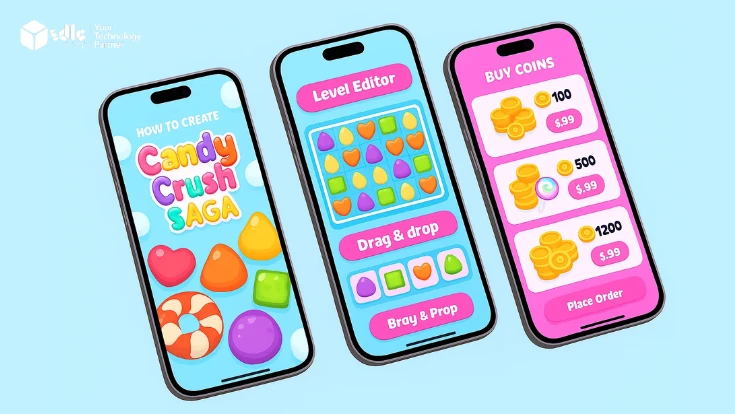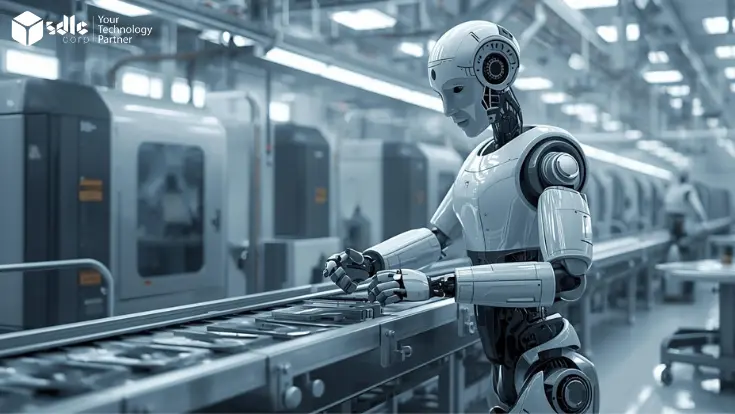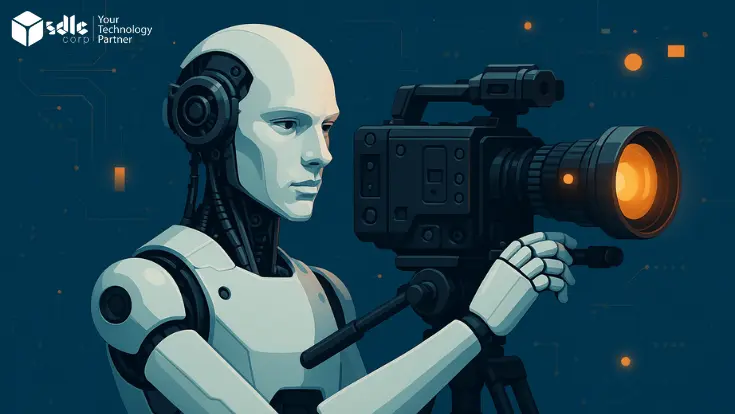Introduction
Candy Crush started as a simple matching game and became one of the world’s most popular mobile apps. With billions of downloads and massive yearly revenue, it’s proof that small ideas can grow into global hits.
If you’ve ever wanted to build a game like Candy Crush Saga, this guide will show you how. You’ll learn which tools to use, how to design fun levels, what it costs to develop, and how to make money from your game.
By the end, you’ll know exactly what it takes to create a match-3 puzzle game players enjoy and keep coming back to.
Why Make a Game Like Candy Crush?
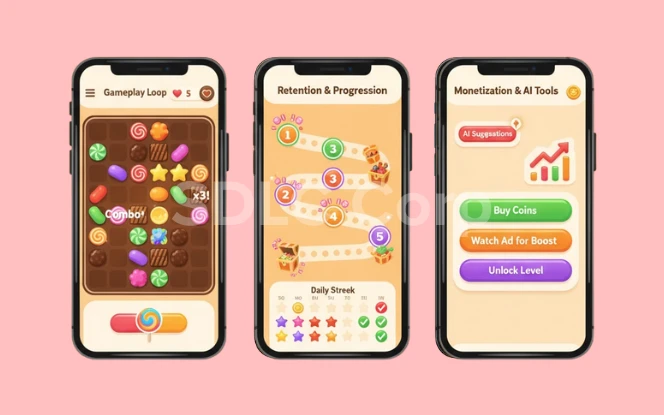
Candy Crush is more than a casual game. It’s a business model that turned a simple match-3 puzzle into one of the most successful mobile franchises in history. With more than 2.7 billion downloads and over 270 million monthly players, it continues to earn more than a billion dollars a year.
That level of engagement makes it a benchmark for anyone entering the puzzle game market. Developing a game like Candy Crush is appealing because it shows how accessible design can drive massive growth. In practical terms, this means:
- Creating a game that’s easy to learn but challenging to master, keeping players engaged across hundreds of levels.
- Building emotional satisfaction through color, sound, and progress that rewards effort and consistency.
- Designing for long-term retention with new levels, events, and updates that keep the experience fresh.
- Monetizing through in-app purchases and ads, using a proven freemium model that continues to dominate mobile gaming revenue.
Because puzzle games combine simple gameplay with high engagement, they offer both creative and commercial potential. Developers who find their own theme or mechanic within this formula can capture a loyal audience and build a sustainable business.
Find Your Unique Game Idea and Target Audience
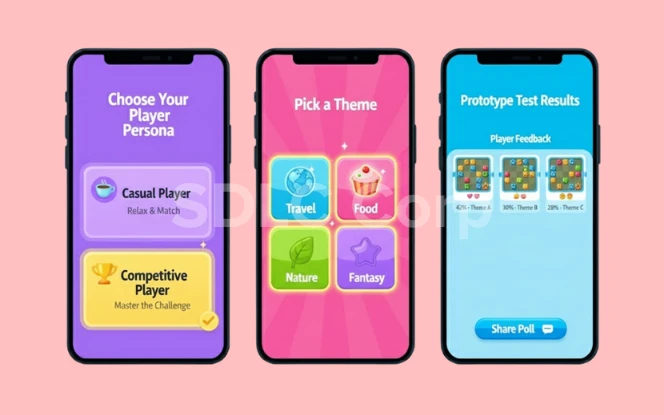
Every great game starts with a clear audience and a fresh concept. The match-3 market is competitive, but new ideas still stand out when they connect with players’ interests and emotions.
Candy Crush succeeded because it spoke to both casual players who wanted relaxation and goal-driven players who enjoyed steady challenges. To shape your own idea, focus on:
- Knowing your audience. Define who your players are and what they enjoy. Casual gamers prefer quick, stress-free sessions, while competitive players value progress and strategy.
- Picking a strong theme. A familiar theme helps your game feel approachable. Travel, food, nature, or fantasy settings often appeal to a wide range of players.
- Testing early. Share simple prototypes or polls on social media to see what players respond to before full development begins.
- Adding a twist. A single new feature, story element, or power-up can make your game feel different even within a known genre.
When you know who you’re building for and what makes your idea special, your design choices become clearer and marketing becomes easier. That understanding sets the foundation for everything that follows in development.
Choosing the Right Tech Stack and Game Engine
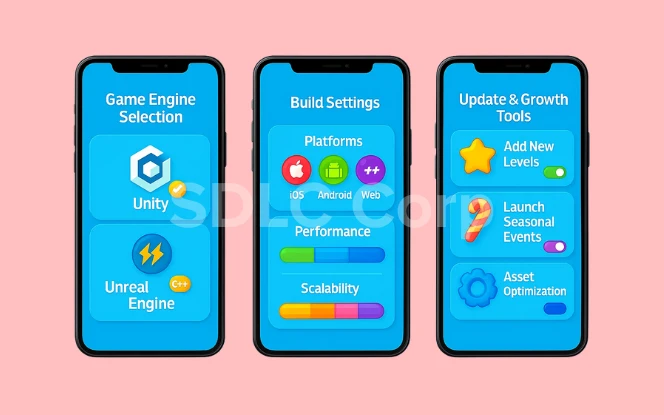
Match-3 games are often built with flexible, mobile-friendly engines that balance speed, visuals, and scalability.
When deciding which tools to use, consider:
- Development engine. Unity and Unreal are the two most popular options. Unity is beginner-friendly and ideal for 2D or simple 3D puzzle games, while Unreal is better suited for advanced visuals and effects.
- Programming language. C# is the standard for Unity, while C++ powers most Unreal projects. Both are efficient and supported by large developer communities.
- Cross-platform support. Choose an engine that allows easy deployment across iOS, Android, and web platforms. This saves time and increases your game’s reach from the start.
- Scalability and updates. Pick tools that make it easy to add new levels, events, or seasonal themes later. Long-term flexibility is just as important as launch performance.
Selecting the right tech stack ensures smoother gameplay and fewer development issues. It also positions your project to grow, whether you plan a simple launch or a long-term mobile franchise.
Designing Game Mechanics and Level Flow
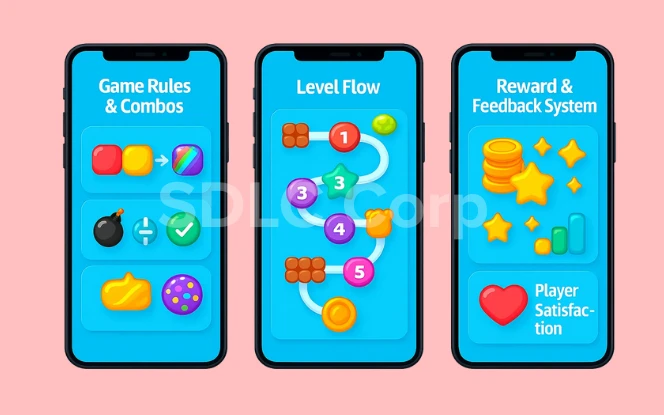
When shaping your game’s flow, focus on:
- Core gameplay rules. Define how matches work, what triggers combos, and how tiles interact. The basic three-in-a-row concept should feel smooth and intuitive from the first tap.
- Progression and difficulty. Gradually increase complexity by adding new goals, obstacles, or power-ups. A balanced learning curve keeps players challenged without creating frustration.
- Reward systems. Use coins, boosters, and visual effects to make success feel satisfying. Each small win should encourage another try.
- Analytics-driven tuning. Collect player data to refine level balance. Track where users get stuck or drop off and adjust difficulty to improve retention.
Visuals, UI/UX, and Audio Design
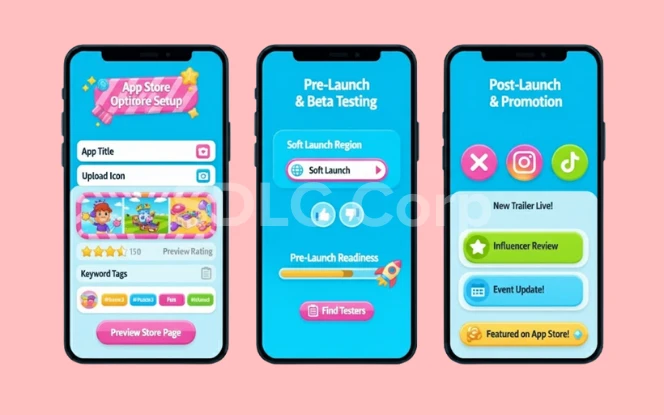
How your game looks and sounds plays a big role in how it feels to play. Visuals and audio shape a player’s emotions, guiding how they react to every move. In match-3 games, clear design and sensory feedback help players focus, stay relaxed, and enjoy the experience without distraction.
To create a strong player experience, focus on:
- Clear and colorful visuals. Use bright but balanced colors that make tiles and icons easy to read. Avoid clutter, and let the board be the center of attention.
- Simple, responsive interface. Keep menus, buttons, and animations smooth and intuitive. Players should never need to guess where to tap or how to navigate.
- Consistent art direction. Choose an art style that matches your theme and stick to it. Whether it’s soft pastel tones or bold candy colors, consistency builds recognition.
- Sound and feedback. Use satisfying pops, chimes, and background music to create a reward loop. Audio should enhance gameplay, not overwhelm it.
Good design makes your game feel effortless to play. When visuals and sounds work together, players become immersed and form an emotional connection that keeps them coming back.
Monetization and Retention Strategy
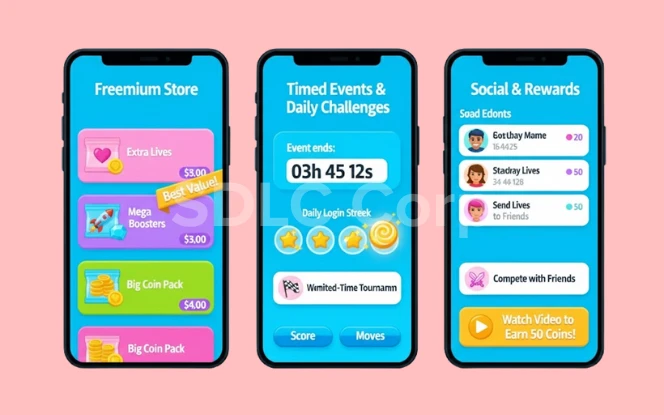
A strong monetization plan turns a good game into a lasting business. Match-3 games like Candy Crush prove that free games can earn steady income when designed with balance and fairness. The goal is to keep players engaged while giving them valuable reasons to spend.
To make your game profitable and engaging, focus on:
- Freemium model. Keep the base game free and offer paid extras like boosters or extra lives. It widens your audience and keeps spending optional.
- Timed events. Daily challenges or seasonal events motivate players to return and often lead to higher in-app purchases.
- Smart ad placement. Use rewarded ads that offer coins or bonuses. Avoid intrusive ads that interrupt gameplay.
- Social play. Add leaderboards or friend-based features to build connection and habit. Players who share progress stay longer.
Good monetization feels like part of the fun, not an obstacle. When players enjoy the experience, retention grows naturally, and so does your revenue.
Cost and Development Timeline
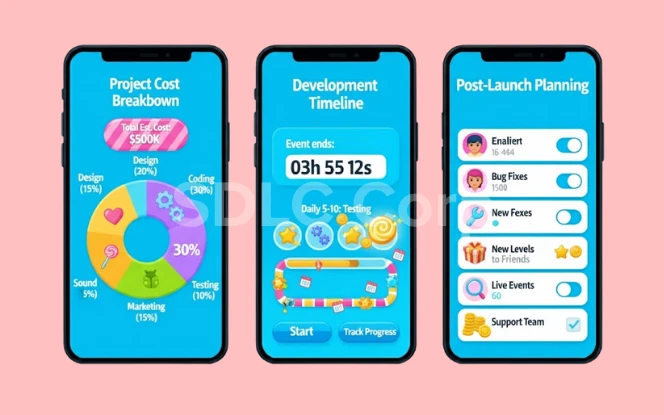
Understanding the cost of creating a match-3 game helps you plan your budget and avoid surprises. The price depends on scope, design quality, team size, and the platforms you target. A small but well-organized team can produce a polished game faster and at a fraction of the cost of larger studios.
When estimating your project, consider:
- Overall cost range. Most match-3 games cost between $30,000 and $200,000 depending on features, graphics, and complexity.
- Timeline. Development usually takes four to six months, including design, coding, testing, and optimization.
- Cost breakdown. Design and development take the largest share, followed by graphics, sound, testing, and marketing. Each stage affects both quality and timeline.
- Post-launch expenses. Set aside budget for live updates, bug fixes, and new levels. Ongoing support helps keep players active and revenue steady.
Knowing these numbers gives you control. A realistic plan keeps development smooth and helps you make better decisions about features, tools, and long-term growth.
Marketing, ASO, and Launch Strategy

A strong launch can decide how far your game goes. Even a great product can fail without visibility, while well-marketed games often outperform stronger competitors. Marketing should start long before release and continue after launch to build steady growth and loyal players.
To plan an effective launch, focus on:
- App Store Optimization (ASO). Write a clear, keyword-rich description, use an appealing icon, and add high-quality screenshots or a short trailer. These elements improve downloads and rankings.
- Pre-launch testing. Run beta tests to gather early feedback and fix performance issues. Soft launches in select regions help you refine balance and monetization before a full release.
- Social media and community. Share updates, behind-the-scenes content, and early gameplay clips. Building excitement ahead of launch makes players feel part of the process.
- Post-launch promotion. Keep visibility high with influencer reviews, update announcements, and seasonal campaigns. Ongoing activity tells both players and platforms that your game is alive and improving.
Marketing doesn’t end when the game goes live. Consistent updates and active communication build long-term visibility, helping your match-3 game grow well beyond its release date.
Post-Launch Updates and Analytics
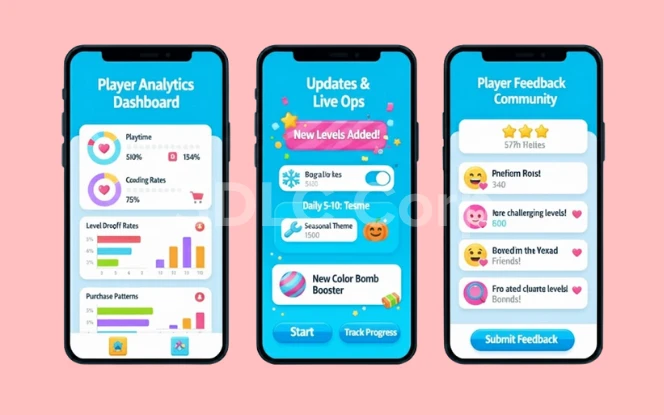
The work doesn’t stop once your game is released. The most successful match-3 games grow stronger through regular updates and data-driven decisions. Analytics help you understand how players behave, what they enjoy, and where they lose interest. Acting on that information keeps your game fresh and profitable.
To strengthen your game after launch, focus on:
- Player analytics. Track key metrics such as playtime, level completion rates, and purchase patterns. This data helps identify what works and what needs adjustment.
- Regular updates. Add new levels, boosters, and seasonal themes to keep players curious. Even small updates remind users that the game is active and worth revisiting.
- Live events. Limited-time challenges and competitions increase engagement and often boost in-app purchases. Players enjoy goals that reset regularly.
- Feedback loops. Collect reviews, monitor social discussions, and respond to suggestions. Players who feel heard are more likely to stay loyal.
Strong post-launch support turns a good release into a long-term success. Continuous improvement and responsive design help your game stay relevant while maintaining a growing community.
Alternatives and Future Trends
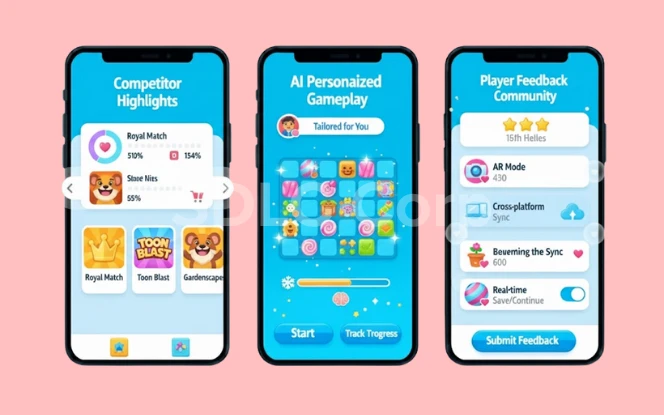
Here’s what’s shaping the next generation of match-3 games:
- Emerging competitors. Titles like Royal Match, Toon Blast, and Gardenscapes have gained massive audiences by adding richer stories and dynamic visuals. Each one builds on Candy Crush’s core idea but offers a fresh experience.
- Personalization through AI. Developers are starting to use artificial intelligence to tailor levels and difficulty to individual players. Personalized gameplay keeps users engaged longer.
- Augmented and mixed reality. AR puzzle games are beginning to appear, blending digital challenges with real-world environments for more immersive play.
- Cross-platform play. Players increasingly expect progress to sync across devices. Games that offer this flexibility tend to retain users longer.
Conclusion
Building a game like Candy Crush Saga takes creativity, focus, and a clear plan. The match-3 format remains one of the most accessible and profitable in mobile gaming because it’s easy to play and endlessly customizable.
Success comes from combining solid gameplay with appealing design, balanced monetization, and steady post-launch support. When these elements work together, a simple idea can grow into a long-term brand players enjoy and remember.
Candy Crush set the standard, but there’s still space for new ideas. With the right concept and consistent effort, your version can find its own audience and success.
Frequently Asked Questions
How long does it take to develop a game like Candy Crush Saga?
Timelines vary, but most match-3 games take between four and six months from concept to release. A smaller, simpler version can launch faster, while feature-rich games with animations or storylines take longer. At SDLC Corp, each phase from design to testing is tailored to match project goals and keep progress consistent.
What is the typical cost of creating a match-3 puzzle game?
The cost depends on the game’s scale. Basic puzzle games may start around $30,000, while advanced versions with custom art, sound, and live features can reach $150,000 or more. SDLC Corp helps clients plan budgets that stay transparent and flexible through every step of development.
Which game engine is best for developing a match-3 game?
Unity is the most popular engine for puzzle games because it’s reliable, mobile-friendly, and easy to scale. Unreal Engine is another strong choice if you want more advanced visuals or effects. SDLC Corp often works with Unity to deliver high performance and quick development.
How can I make my game as engaging as Candy Crush?
Focus on balance. Keep levels simple to start but gradually increase the challenge. Add satisfying feedback through sound, animation, and rewards. At SDLC Corp, we use player testing and analytics to refine engagement and create a smooth gameplay experience.
Can a small business or startup create a successful puzzle game?
Yes. Many hit puzzle games began as indie projects. What matters most is creativity and consistent updates. Even small teams can succeed with one strong concept. SDLC Corp supports startups with scalable solutions that match their goals and budget.
How can I monetize my game effectively without annoying players?
Combine in-app purchases with optional, reward-based ads that don’t interrupt gameplay. Offer upgrades or bonuses that feel useful but never forced. SDLC Corp helps design fair monetization models that keep players happy while generating steady income.
What happens after the game launches?
Post-launch development focuses on growth. Regular updates, new levels, and live events keep players engaged. SDLC Corp provides ongoing support, analytics, and optimization services to help games stay active and profitable long after release.
Is now a good time to enter the puzzle game market?
Yes. The global puzzle game market continues to expand with space for new ideas and audiences. Players look for games that are relaxing, creative, and rewarding. With the right strategy and a skilled partner like SDLC Corp, this is an ideal time to start developing your game.

